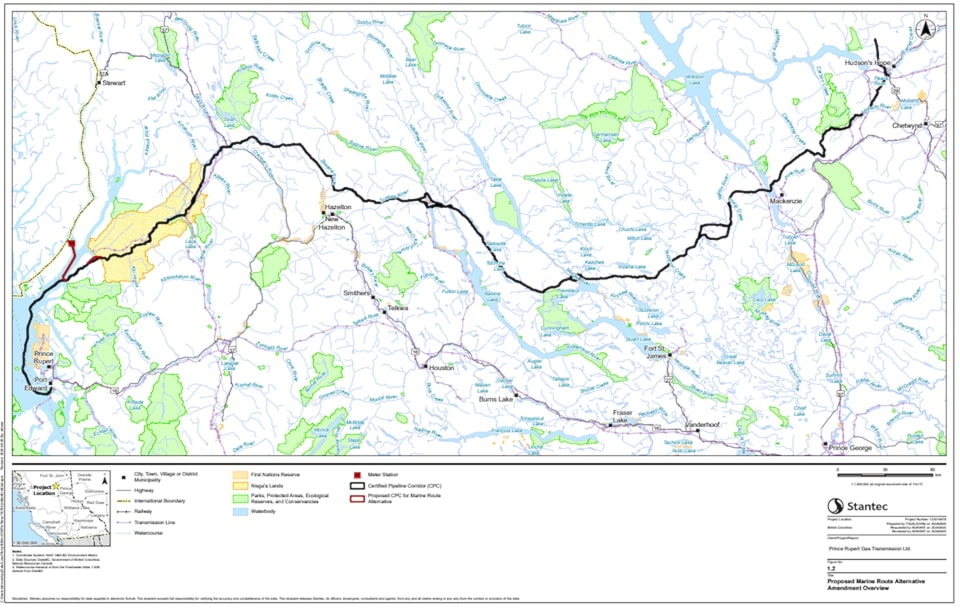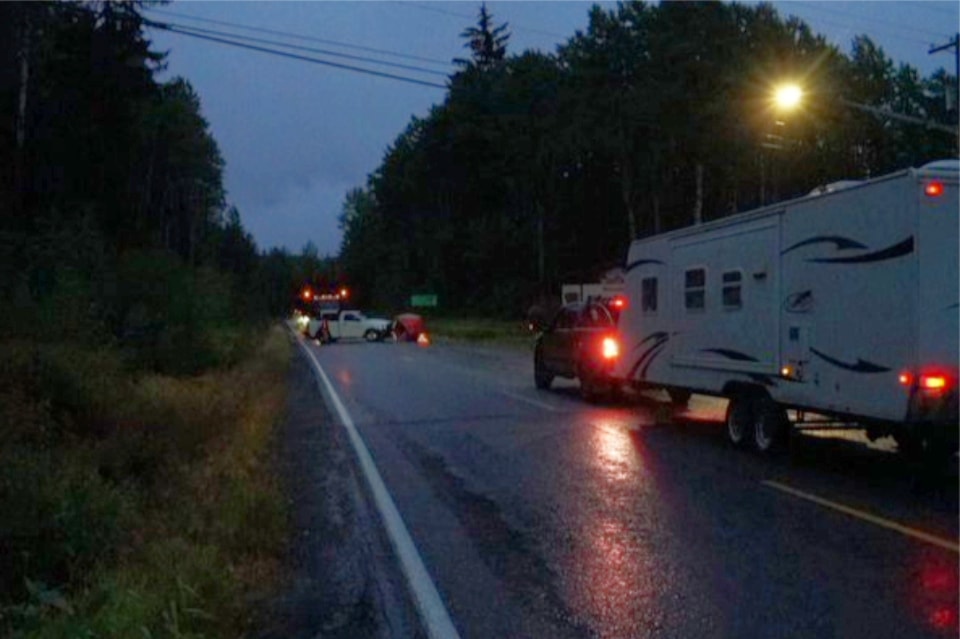A group of Indigenous young people have blockaded access to a work camp site for a natural gas pipeline to feed a proposed liquefied natural gas project on B.C.'s north coast.
The blockade was set up on Aug. 22 at Cranberry Junction where the access road for the pipeline project site meets Highway 37, approximately 170 kilometres north of Terrace. It is the shortest route to transport the equipment and supplies necessary for the pipeline's Nass work camp. The Nass Forest Service Road was also closed to pipeline vehicles.
The Prince Rupert Gas Transmission (PRGT) pipeline and Ksi Lisims plant are liquefied natural gas projects in northern B.C. The PRGT line is being built in a limited partnership between the Nisga'a Nation and Western LNG, and Ksi Lisims is a Western LNG project backed by the Nisga'a Nation.
On the remote service road, Gitanyow Simigiget (hereditary chiefs) burned a benefits agreement they signed 10 years ago with TC Energy, the previous owner of the PRGT line.
"They're not welcome [here]," said Gamlakyeltxw (Wil Marden), a chief of the Ganeda Clan, at the blockade before the agreement was burned.
So far, around 50 community members are showing up every day at the blockade. Gamlakyeltxw said they plan to stay there until November when the current environmental certificate for the project expires.
Rebecca Scott a spokesperson for Western LNG said the partnership believes in the rights of free speech and peaceful assembly, but this demonstration has not deterred them from proceeding.
"We also expect opposition and protest as a part of building any big project. In this case, the trucks found other routes to their destination and construction will proceed as planned," said Rebecca Scott, a Western LNG spokesperson.
On Aug. 19, youth took turns speaking out against the PRGT pipeline and Ksi Lisims offshore LNG processing plant projects, asking leaders to listen during a meeting at the Gitanmaax Hall on Aug. 19. More than 300 people attended the "Pipeline Impact Meeting" in person, with more attending via live stream, according to a press release.
Naxginkw (Tara Marsden), a Gitanyow member who works with the hereditary chiefs, questioned at the meeting whether the Gitanyow were given all the info they needed to make an informed decision years ago.
The difference today, she said, comes down to two factors. The Gitanyow have since implemented fish and wildlife programs that have helped them understand how the habitat will be affected by these projects.Youth were also not involved in the decision to sign the previous agreement.
"The youth and future generations were left out of [the pipeline] conversation, and I'm scared for my future," said Drew Harris, a youth organizer for the Skeena Watershed Conservation Coalition.
"I just want you to remember we don't own the land, the land owns us. If we continue to contaminate our waters, pollute our air and deplete our food sources, where does that leave us?"
Gamlakyeltxw recalled that in 2014, he was told by government and PRGT representatives that the pipeline project would go ahead with or without the permission of Gitanyow.
A point of contention is current status of the PRGT environmental assessment certificate, which was issue 10 years ago.
"As far as we're concerned, this pipeline needs a new environmental assessment," said Gamlakyeltxw.
The pipeline's environmental assessment certificate was issued in 2014 when the line was set to connect to a Petronas LNG export facility near Prince Rupert. That project was cancelled in 2017. In 2019, TC Energy applied for and received a five-year extension to the certificate, which expires in November unless the Nisga'a - Western LNG partnership can demonstrate the project has been "substantially started."
The PRGT line was originally supposed to stretch across northern B.C., turn south at Nass Bay and continue to Port Edward to the proposed Petronas facility. Now, the line would travel north at the Gasoga Gulf, heading up the Portland Inlet to the north end of Pearse Island to supply the proposed Ksi Lisims facility near the Nisga'a village of Gingolx.
Scott said they expect an amendment to the environmental assessment to be approved by the end of the year.
Gamlakyeltxw said Gitanyow plans to conduct an independent environmental assessment.

Nathan Cullen, MLA for Stikine, said it is a complicated situation.
"It's a bit of a chicken and egg question, because the proponents are trying to demonstrate a substantial start," Cullen said.
"People are wondering how they are able to build while existing under an old project that looks so different. It's understandable why folks are raising those concerns. The environmental assessment office and others will have to communicate as to how this all fits together, and that the process is public and it's fair, and that the consultations are meaningful."
During the Aug. 19 meeting, Gitanyow fish and wildlife programs staff shared data on how the PRGT line would destroy the habitat of the fish in the Kispiox River, which is currently deemed too sensitive for a catch-and-release fishery. The line intersects with the river, which brings to question how it will cross the river.
In most cases, a trench is dug through the river, which would affect the habitat. However, Scott said they will use other technologies to ensure waterway impacts are as minor as possible, but she could not confirm which methods they may use.
Other measures to protect the habitat include engineering infrastructure such as clear-span bridges, fish salvage and relocation, and fish habitat offsetting. The specifics for these measures are not clear at this point.
"PRGT will continue to seek and support constructive dialogue with right-of-way Nations, with a focus on resolving issues and realizing the opportunities ahead," said Scott. "We will also continue to advance the PRGT project under the Nisga'a principles of unity, respect, and compassion."
Regarding the potential economic opportunities these projects will bring to the region, Cullen said most of the construction work that people have done for LNG work in the past has gone to people who come from outside of the region.
Also at the Aug. 19 meeting, the Gitanyow hereditary chiefs discussed taking legal action against the Province of B.C. Attendees at the meeting contributed more than $3,500 for Nisga'a community members who want an injunction against the construction start.
More community meetings will be held in the coming weeks.

